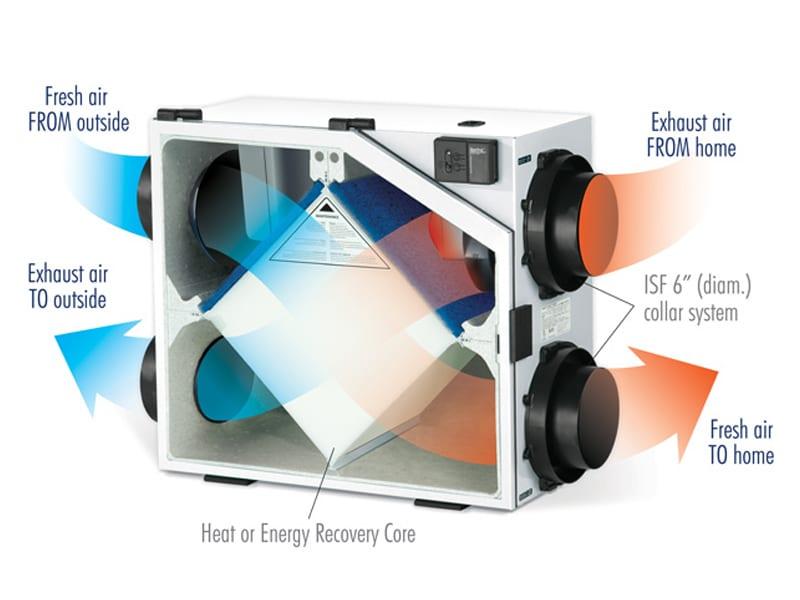More and more local municipalities require that new homes and major remodels enlist the services of a HERS rater. It’s the job of the HERS rater to advise their clients on energy-related product selection, installation and afterward provide certified verification through testing. Among the product choices in the HERS rater toolbox are ERVs.

What is an ERV?
ERV stands for energy recovery ventilation. This clever device brings fresh outside air into your home while exhausting in equal amounts stale inside air otherwise known as conditioned air. During this process, the energy contained in the outgoing air is transferred into the incoming air. In contrast, an exhaust-only system provides no balance and no mechanism for capturing the energy from the outgoing conditioned air. ERV’s come in various sizes and can be used to provide balanced ventilation to just one room or to the entire home.
HRV vs ERV?
What is the difference between an HRV and an ERV? HRVs and ERVs are similar devices in that both supply fresh air and exhaust stale air while recovering energy. The primary difference, an HRV captures heat, while an ERV captures both heat and moisture.
How Much Does an ERV Cost?
This depends on the following:
- Whether it is a stand-alone system or integrated into an existing ducted HVAC system.
- Whether it is a whole house system with air inlets and exhaust ports in multiple rooms, or it is used for spot ventilation in one room only, such as a craft room or home office.
These units come in various sizes. Smaller homes have less square footage and volume when compared to larger homes. The manufacturers of ERVs produce these units in different sizes in order to accommodate different needs. A whole-house approach will require a large unit and will include numerous air inlets and exhaust ports strategically located to service different rooms. A one-room approach will require a small unit and usually consists of only one air inlet and one exhaust outlet. Prices can range from as little as $1500 to as much as $15000 or more depending on the application.
Where to Place ERV Inlet & Exhaust Ports?
The fresh air intake ports which pull air directly from outside should be located away from any potential pollution source such as:
- Chimney flues
- Driveways
- Dryer exhaust ports
- Bathroom fan exhaust ports
- Range hood exhaust ports
- propane tanks or gas meters
- Garbage cans
- Busy roadways
Exhaust air ports should be located away from building openings such as:
- Windows
- Exterior doors, including garage and bulkhead doors
- Soffit vents meant to provide ventilation to the attic area
- Outdoor gathering areas
Is an ERV Worth It?
Because of the energy recovery function built into these units, ERV systems save energy by reducing the need to cool or heat incoming outside air. Although energy consumption from fans may increase after an ERV system installation, the savings in heating and cooling energy generally far outweigh any increases.
Does an ERV Reduce Humidity?
ERV ventilation solutions offer balance, humidity control and comfort. Did you know that most of the energy needed to cool a home goes to removing humidity? Remember, unlike HRV’s, ERVs also remove humidity from incoming air, greatly reducing cooling costs.
What Effect Does an ERV Have on a HERS Rating
Homes that attain lower (more favorable) HERS Rating scores almost exclusively have Energy Recovery Ventilators (ERVs) or Heat Recovery Ventilators (HRVs). Homes with higher (less favorable) HERS Rating are more likely to have exhaust only ventilation, such as a typical bathroom exhaust fan. If you’d like more information on how you can minimize energy consumption while making your home more comfortable and affordable all year round, then contact Energy Geeks. Our mission is to provide the most comprehensive and efficient solutions to reduce energy use in your home.
Call: 401-766-1540 | 508-444-9800 | Get No Cost Estimate


